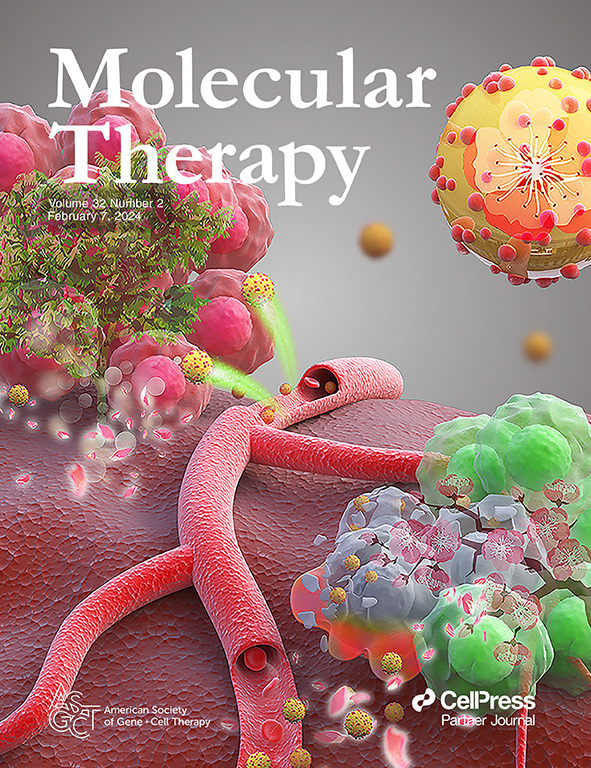Real-World Outcomes of Delandistrogene Moxeparvovec Gene Therapy: Motor Outcomes and Emerging Safety Concerns.
IF 12
1区 医学
Q1 BIOTECHNOLOGY & APPLIED MICROBIOLOGY
引用次数: 0
Abstract
Delandistrogene moxeparvovec is currently the only commercially approved gene therapy for Duchenne muscular dystrophy (DMD). Herein we report real-world data of 11 ambulatory DMD patients, ages 4-6, treated with commercial delandistrogene moxeparvovec. Patients were prospectively and uniformally monitored for 1 year post-gene-transfer for safety and motor outcomes. Nine patients experienced 15 treatment-related toxicities; 4 required escalation of corticosteroids. Side effects included gastrointestinal symptoms (n=7), liver enzyme abnormalities (n=4), acute liver injury (n=2), and troponin-I elevations (n=3). In both patients with acute liver injury, troponin-I elevations occurred in close temporal association beginning 8-9 weeks post-gene-transfer that were responsive to corticosteroids. The clinical courses of these two patients was at least partially consistent with a cellular immune response to the AAV capsid. Troponin-I elevations were asymptomatic and without acute functional changes on echocardiogram. The cohort had improvements in year 1 motor function assessments relative to baseline, including a statistically significant median 4-point increase in North Star Ambulatory Assessment score; however, important confounding factors, e.g. baseline corticosteroid use, limit interpretation and will be important to control for in future real-world data sets. Additional follow-up is required to determine long-term safety and motor outcomes with unclear generalizability of our results.Delandistrogene moxparvovec基因治疗的实际结果:运动结果和新出现的安全性问题。
Delandistrogene moxeparvovec是目前唯一获得商业批准的治疗杜氏肌营养不良症(DMD)的基因疗法。在此,我们报告了11名年龄4-6岁的动态DMD患者的真实数据,这些患者接受了商业delandistrogene moxeparvovec治疗。在基因转移后的1年内,对患者进行前瞻性和统一的安全性和运动预后监测。9例患者出现15种与治疗相关的毒性反应;4例需要增加皮质类固醇的剂量。副作用包括胃肠道症状(n=7)、肝酶异常(n=4)、急性肝损伤(n=2)和肌钙蛋白- 1升高(n=3)。在两例急性肝损伤患者中,肌钙蛋白- 1升高在基因转移后8-9周开始出现密切的时间关联,并对皮质类固醇有反应。这两名患者的临床病程至少部分符合对AAV衣壳的细胞免疫反应。超声心动图显示肌钙蛋白- 1升高无症状,无急性功能改变。与基线相比,该队列在第一年的运动功能评估方面有改善,包括North Star动态评估评分中位数有统计学意义的4分增加;然而,重要的混杂因素,如基线皮质类固醇使用,限制了解释,并且在未来的真实世界数据集中控制将是重要的。需要额外的随访来确定长期安全性和运动结果,我们的结果不明确。
本文章由计算机程序翻译,如有差异,请以英文原文为准。
求助全文
约1分钟内获得全文
求助全文
来源期刊

Molecular Therapy
医学-生物工程与应用微生物
CiteScore
19.20
自引率
3.20%
发文量
357
审稿时长
3 months
期刊介绍:
Molecular Therapy is the leading journal for research in gene transfer, vector development, stem cell manipulation, and therapeutic interventions. It covers a broad spectrum of topics including genetic and acquired disease correction, vaccine development, pre-clinical validation, safety/efficacy studies, and clinical trials. With a focus on advancing genetics, medicine, and biotechnology, Molecular Therapy publishes peer-reviewed research, reviews, and commentaries to showcase the latest advancements in the field. With an impressive impact factor of 12.4 in 2022, it continues to attract top-tier contributions.
 求助内容:
求助内容: 应助结果提醒方式:
应助结果提醒方式:


